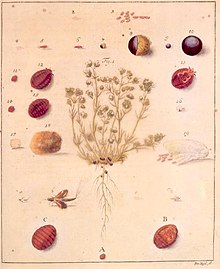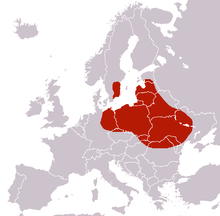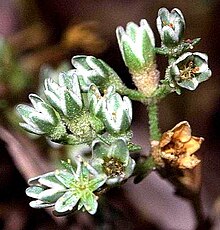
Lac is the resinous secretion of a number of species of lac insects, of which the most commonly cultivated is Kerria lacca.
Galls or cecidia are a kind of swelling growth on the external tissues of plants. Plant galls are abnormal outgrowths of plant tissues, similar to benign tumors or warts in animals. They can be caused by various parasites, from viruses, fungi and bacteria, to other plants, insects and mites. Plant galls are often highly organized structures so that the cause of the gall can often be determined without the actual agent being identified. This applies particularly to insect and mite plant galls. The study of plant galls is known as cecidology.
Crimson is a rich, deep red color, inclining to purple. It originally meant the color of the kermes dye produced from a scale insect, Kermes vermilio, but the name is now sometimes also used as a generic term for slightly bluish-red colors that are between red and rose. It is the national color of Nepal.
Carmine – also called cochineal, cochineal extract, crimson lake, or carmine lake – is a pigment of a bright-red color obtained from the aluminium complex derived from carminic acid. Specific code names for the pigment include natural red 4, C.I. 75470, or E120. Carmine is also a general term for a particularly deep-red color.
A lake pigment is a pigment made by precipitating a dye with an inert binder, or mordant, usually a metallic salt. Unlike vermilion, ultramarine, and other pigments made from ground minerals, lake pigments are organic. Manufacturers and suppliers to artists and industry frequently omit the lake designation in the name. Many lake pigments are fugitive because the dyes involved are not lightfast. Red lakes were particularly important in Renaissance and Baroque paintings; they were often used as translucent glazes to portray the colors of rich fabrics and draperies.

Scale insects are small insects of the order Hemiptera, suborder Sternorrhyncha. Of dramatically variable appearance and extreme sexual dimorphism, they comprise the infraorder Coccomorpha which is considered a more convenient grouping than the superfamily Coccoidea due to taxonomic uncertainties. Adult females typically have soft bodies and no limbs, and are concealed underneath domed scales, extruding quantities of wax for protection. Some species are hermaphroditic, with a combined ovotestis instead of separate ovaries and testes. Males, in the species where they occur, have legs and sometimes wings, and resemble small flies. Scale insects are herbivores, piercing plant tissues with their mouthparts and remaining in one place, feeding on sap. The excess fluid they imbibe is secreted as honeydew on which sooty mold tends to grow. The insects often have a mutualistic relationship with ants, which feed on the honeydew and protect them from predators. There are about 8,000 described species.

Carminic acid (C22H20O13) is a red glucosidal hydroxyanthrapurin that occurs naturally in some scale insects, such as the cochineal, Armenian cochineal, and Polish cochineal. The insects produce the acid as a deterrent to predators. An aluminum salt of carminic acid is the coloring agent in carmine, a pigment. Natives of Peru had been producing cochineal dyes for textiles since at least 700 CE. Synonyms are C.I. 75470 and C.I. Natural Red 4.

Kermes is a red dye derived from the dried bodies of the females of a scale insect in the genus Kermes, primarily Kermes vermilio. The Kermes insects are native in the Mediterranean region and are parasites living on the sap of the host plant, the Kermes oak and the Palestine oak.

An animal product is any material derived from the body of a non-human animal. Examples are fat, flesh, blood, milk, eggs, and lesser known products, such as isinglass and rennet.

Delia flies are members of the Anthomyiidae family within the superfamily Muscoidae. The identification of different species of Delia can be very difficult for non-specialists as the diagnostic characteristics used for immature and/or female specimens may be inconsistent between species. Past taxonomic keys were not as comprehensive in their identification of Delia specimens; they were either too reliant on genetic characteristics, focused solely on a specific life stage, or were focused only on certain species. However current taxonomic keys aim to be more thorough by not only including morphological diagnostics for males, females, and immature specimens of various species, but also their genetic make-up or molecular barcode.

Johann Philipp Breyne FRS, son of Jacob Breyne (1637–97), was a German-Polish botanist, palaeontologist, zoologist and entomologist. He is best known for his work on the Polish cochineal, an insect formerly used in production of red dye. Proposed by Hans Sloane, he was elected, on 21 April 1703, a Fellow of the Royal Society. He was also a member of the German Academy of Sciences Leopoldina and the Societas Litteraria
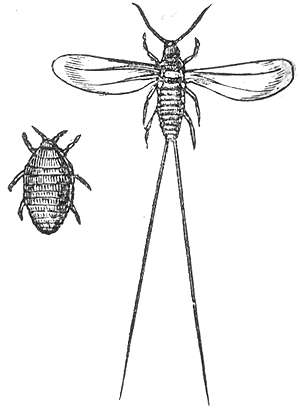
The cochineal is a scale insect in the suborder Sternorrhyncha, from which the natural dye carmine is derived. A primarily sessile parasite native to tropical and subtropical South America through North America, this insect lives on cacti in the genus Opuntia, feeding on plant moisture and nutrients. The insects are found on the pads of prickly pear cacti, collected by brushing them off the plants, and dried.
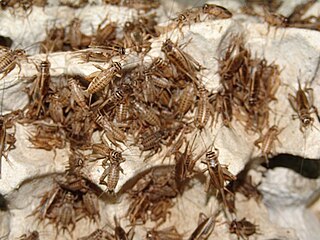
Insect farming is the practice of raising and breeding insects as livestock, also referred to as minilivestock or micro stock. Insects may be farmed for the commodities they produce, or for them themselves; to be used as food, as feed, as a dye, and otherwise.

Natural dyes are dyes or colorants derived from plants, invertebrates, or minerals. The majority of natural dyes are vegetable dyes from plant sources—roots, berries, bark, leaves, and wood—and other biological sources such as fungi.

Dyeing is the craft of imparting colors to textiles in loose fiber, yarn, cloth or garment form by treatment with a dye. Archaeologists have found evidence of textile dyeing with natural dyes dating back to the Neolithic period. In China, dyeing with plants, barks and insects has been traced back more than 5,000 years. Natural insect dyes such as Tyrian purple and kermes and plant-based dyes such as woad, indigo and madder were important elements of the economies of Asia and Europe until the discovery of man-made synthetic dyes in the mid-19th century. Synthetic dyes quickly superseded natural dyes for the large-scale commercial textile production enabled by the industrial revolution, but natural dyes remained in use by traditional cultures around the world.

Dactylopius is a genus of insect in the superfamily Coccoidea, the scale insects. It is the only genus in the family Dactylopiidae. These insects are known commonly as cochineals, a name that also specifically refers to the best-known species, the cochineal. The cochineal is an insect of economic and historical importance as a main source of the red dye carmine. It has reportedly been used for this purpose in the Americas since the 10th century. Genus Dactylopius is also important because several species have been used as agents of biological pest control, and because several are known as invasive species.

The Armenian cochineal, also known as the Ararat cochineal or Ararat scale, is a scale insect indigenous to the Ararat plain and Aras (Araks) River valley in the Armenian Highlands and in Turkey. It was formerly used to produce an eponymous crimson carmine dyestuff known in Armenia as vordan karmir and historically in Persia as kirmiz. The species is critically endangered within Armenia.

Hemipenthes maura is a species of bee fly belonging to the family Bombyliidae.

Red pigments are materials, usually made from minerals, used to create the red colors in painting and other arts. The color of red and other pigments is determined by the way it absorbs certain parts of the spectrum of visible light and reflects the others. The brilliant opaque red of vermillion, for example, results because vermillion reflects the major part of red light, but absorbs the blue, green and yellow parts of white light.
